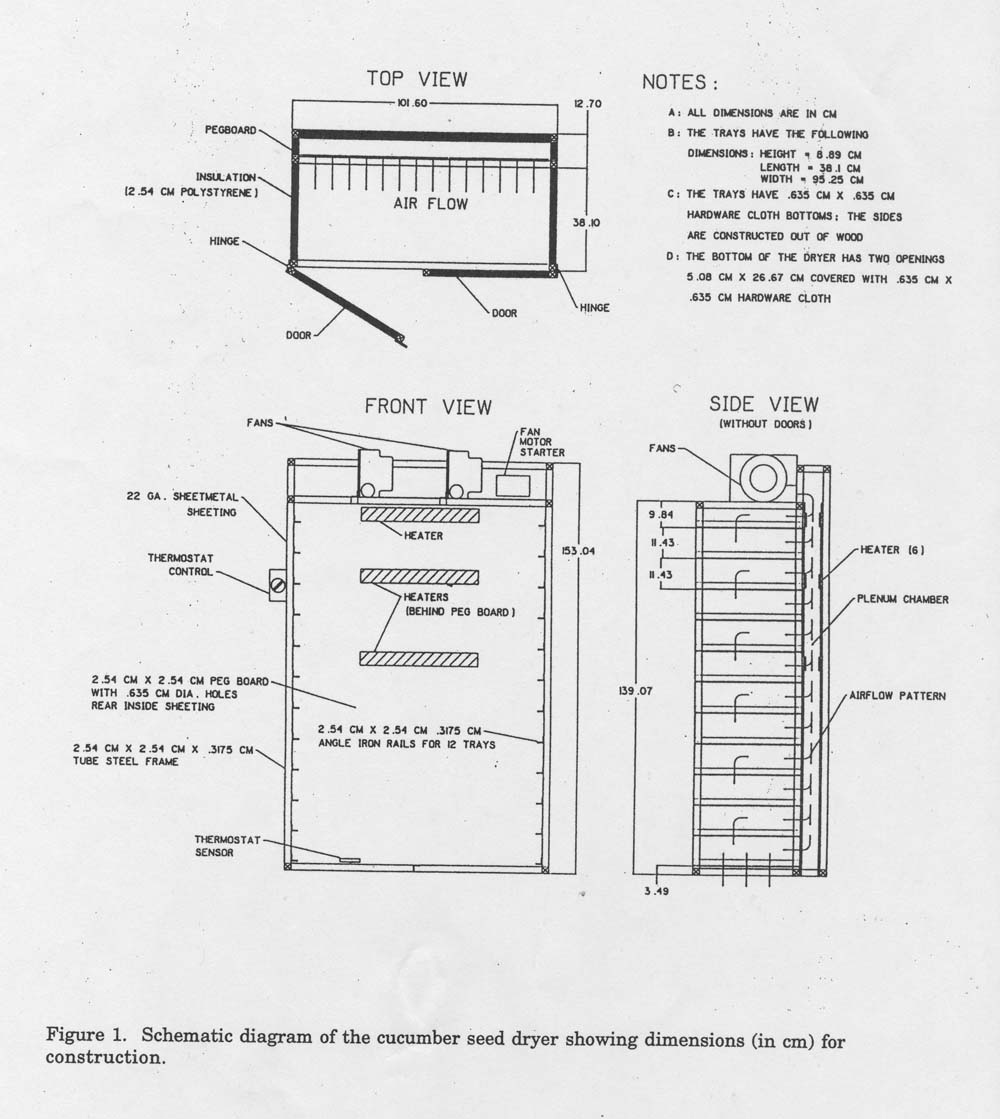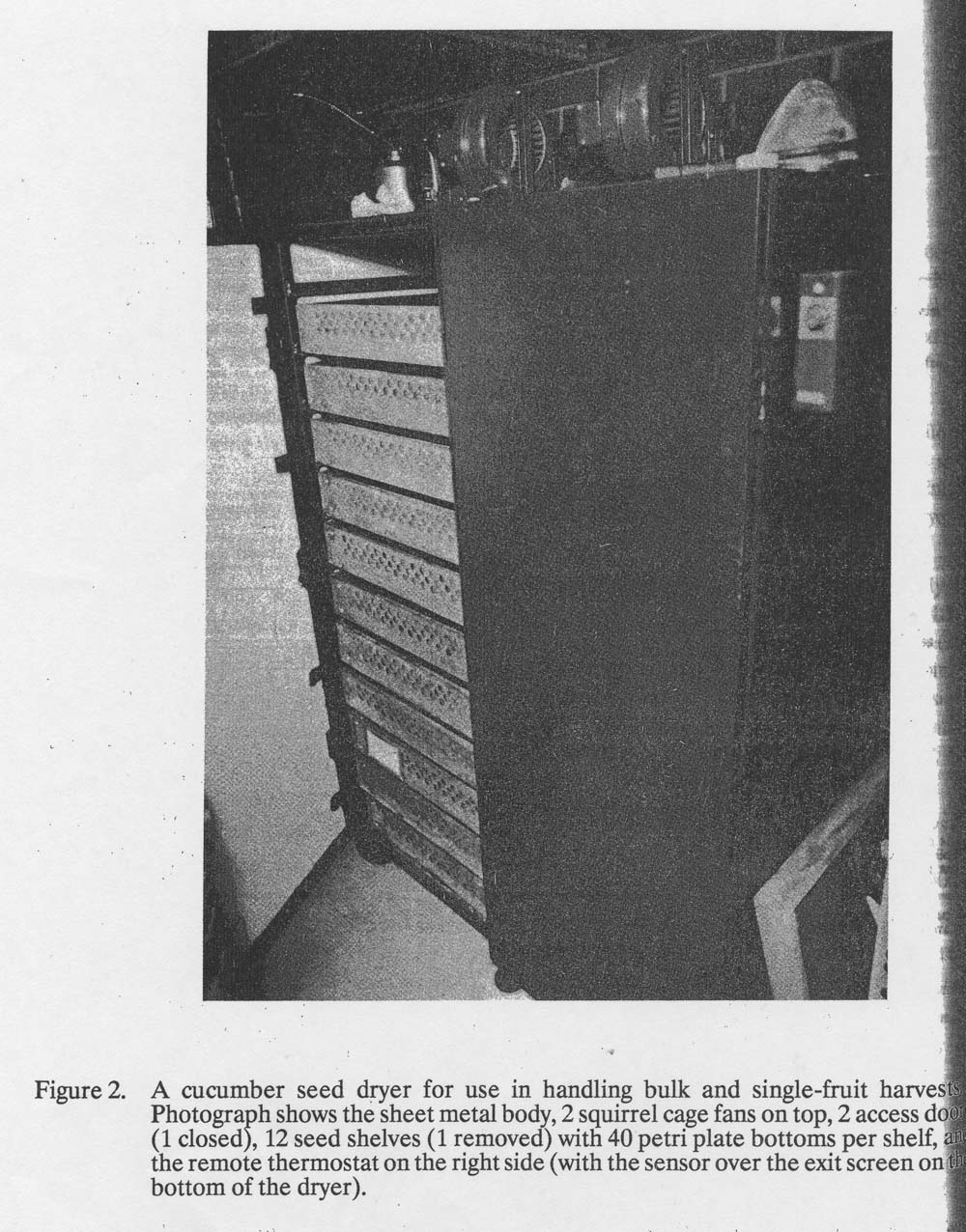Cucurbit Genetics Cooperative Report 17:54-56 (article 14) 1994
Todd C. Wehner and Ervin G. Humphries
Departments of Horticultural Science, and Biological and Agricultural Engineering, North Carolina State University, Raleigh, NC 27695
A dryer was built using readily available parts for use in drying cucumber seeds from single-fruit harvest, as well as bulk increases from isolation blocks. The dryer would undoubtedly work on seeds of other crops as well, but we have no test experience with them in this dryer. The dryer described here is the product of several years of modification, this being the fifth version we have built.
The dryer consists of a large sheet metal box with 2 squirrel cage fans on top (Fig. 1). The fans blow air across heating elements and into a chamber in the back of the box. A baffle lets the air flow across each of the 12 shelves inside the main part of the box. Each of the shelves has a hardware cloth bottom, and can holdup to 2300 g (dry weight) of seeds. The bottom of the ox has a screened opening for the hot air to exit after passing across the seed-drying shelves. A thermostat above the exit opening keeps the seeds from being overheated during the drying process.
The shelves are loaded with seeds that have been washed (after extracting from mature fruits). We have the best success in drying bulk lots of seeds from isolation blocks when we have less than a 14-mm-thick layer of seeds on the screen. Alternatively, shelves can be loaded with seeds from individual fruits (from hand-pollinations). The seeds from each fruit are placed in the bottom half of a plastic, 100 mm-diameter petri plate (the tops are not used) along with the pollination tag. Each shelf will hold 40 plates.
Drying time is faster if the intake air is cool and dry, so that process takes longer under North Carolina conditions in the summer. We set the thermostat at 30 to 32C to dry the seeds, and have them ready to put in packets or bags after 24 (winter) to 36 (summer) hours.
The dryer is inexpensive and easy to build (we use three in our program). Also, it dries seeds safely and rapidly, and keeps rodents and insects away. Dimensions for construction of the dryer are shown in Fig. 1.
The main parts, available commercially, include: one remote thermostat (0 to 50C, 11.5 m capillary, 12 amperes, 240 volts), two fans (2.95 m3 /hr) with motors (150 watts, 1610 revolutions per minute, continuous duty), one motor starter (single pole, double throw, 30 amperes, 600 volts maximum), and six heaters (45 cm long, 650C, 500 watts, 240 volts).
A photograph (Fig. 2) of the dryer shows the general appearance when constructed. We estimate that it required 50 worker-hours and $400 in parts to construct the dryer as shown.
We gratefully acknowledge the assistance of David L. Vermillion for the illustrations and Rufus R. Horton, Jr. for machine testing.
Figure 1. Schematic diagram of the cucumber seed dryer showing dimensions (in cm) for construction.

Figure 2. A cucumber seed dryer for use in handling bulk and single-fruit harvests. Photograph shows the sheet metal body, 2 squirrel cage fans on top, 2 access doors (1 closed), 12 seed shelves (1 removed) with 40 petri plate bottoms per shelf, and the remote thermostat on the right side (with the sensor over the exit screen on the bottom of the dryer).
